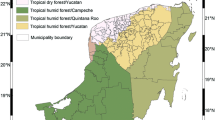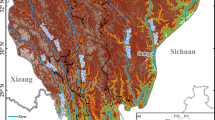Abstract
Several spatial forest disturbance datasets exist for the conterminous USA. The major problem with forest disturbance mapping is that variability between map products leads to uncertainty regarding the actual rate of disturbance. In this article, harmonized maps were produced from multiple data sources (i.e., Global Forest Change, LANDFIRE Vegetation Disturbance, National Land Cover Database, Vegetation Change Tracker, and Web-Enabled Landsat Data). The harmonization process involved fitting common class ontologies and determining spatial congruency to produce forest disturbance maps for four time intervals (1986–1992, 1992–2001, 2001–2006, and 2006–2011). Pixels mapped as disturbed for two or more datasets were labeled as disturbed in the harmonized maps. The primary advantage gained by harmonization was improvement in commission error rates relative to the individual disturbance products. Disturbance omission errors were high for both harmonized and individual forest disturbance maps due to underlying limitations in mapping subtle disturbances with Landsat classification algorithms. To enhance the value of the harmonized disturbance products, we used fire perimeter maps to add information on the cause of disturbance.




Similar content being viewed by others
References
Cohen, W. B., Spies, T. A., Alig, R. J., et al. (2002). Characterizing 23 years (1972-95) of stand replacement disturbance in Western Oregon forests with Landsat imagery. Ecosystems, 5, 122–137. doi:10.1007/s10021-001-0060-X.
Cohen, W. B., Yang, Z., & Kennedy, R. (2010). Detecting trends in forest disturbance and recovery using yearly Landsat time series: 2. TimeSync—tools for calibration and validation. Remote Sensing of Environment, 114, 2911–2924. doi:10.1016/j.rse.2010.07.010.
Cohen, W. B., Yang, Z., Stehman, S. V., et al. (2016). Forest disturbance across the conterminous United States from 1985–2012: the emerging dominance of forest decline. Forest Ecology and Management, 360, 242–252. doi:10.1016/j.foreco.2015.10.042.
Drobne, S., & Lisec, A. (2009). Multi-attribute decision analysis in GIS: weighted linear combination and ordered weighted averaging. Informatica, 4, 28.
Fensholt, R., Rasmussen, K., Nielsen, T. T., & Mbow, C. (2009). Evaluation of earth observation based long term vegetation trends—intercomparing NDVI time series trend analysis consistency of Sahel from AVHRR GIMMS, Terra MODIS and SPOT VGT data. Remote Sensing of Environment, 113, 1886–1898. doi:10.1016/j.rse.2009.04.004.
Finco, M., Quayle, B., Zhang, Y., et al. (2012). Monitoring trends and burn severity (MTBS): monitoring wildfire activity for the past quarter century using Landsat data. In: Moving from Status to Trends: Forest Inventory and Analysis (FIA) Symposium. pp 222–228.
Friedl, M. A., Gray, J. M., Melaas, E. K., et al. (2014). A tale of two springs: using recent climate anomalies to characterize the sensitivity of temperate forest phenology to climate change. Environmental Research Letters, 9, 54006. doi:10.1088/1748-9326/9/5/054006.
Fry, J. A., Coan, M. J., Homer, C. G., et al. (2009). Completion of the National Land Cover Database (NLCD) 1992–2001 Land Cover Change Retrofit Product. U.S. Geological Survey, Open File Report 2008-1379.
Goetz, S. J., Fiske, G. J., & Bunn, A. G. (2006). Using satellite time-series data sets to analyze fire disturbance and forest recovery across Canada. Remote Sensing of Environment, 101, 352–365. doi:10.1016/j.rse.2006.01.011.
Goward, S. N., Masek, J. G., Cohen, W., et al. (2008). Forest disturbance and North American carbon flux. EOS, Transactions, American Geophysical Union, 89(11), 105–116.
Hansen, M. C., Egorov, A., Potapov, P. V., et al. (2014). Monitoring conterminous United States (CONUS) land cover change with Web-Enabled Landsat Data (WELD). Remote Sensing of Environment, 140, 466–484. doi:10.1016/j.rse.2013.08.014.
Hansen, M. C., Egorov, A., Roy, D. P., et al. (2011). Continuous fields of land cover for the conterminous United States using Landsat data: first results from the Web-Enabled Landsat Data (WELD) project. Remote Sens Letters, 2, 279–288. doi:10.1080/01431161.2010.519002.
Hansen, M. C., Potapov, P. V., Moore, R., et al. (2013). High-resolution global maps of 21st-century forest cover change. Science, 342, 850–853. doi:10.1126/science.1244693.
Hansen, M. C., Stehman, S. V., & Potapov, P. V. (2010). Quantification of global gross forest cover loss. Proceedings of the National Academy of Sciences, 107, 8650–8655. doi:10.1073/pnas.0912668107.
Homer, C., Huang, C., Yang, L., et al. (2004). Development of a 2001 national land-cover database for the United States. Photogrammetric Engineering and Remote Sensing, 70, 829–840.
Houghton, R. A. (1999). The U.S. carbon budget: contributions from land-use change. Science, 285, 574–578. doi:10.1126/science.285.5427.574.
Huang, C., Goward, S. N., Masek, J. G., et al. (2010). An automated approach for reconstructing recent forest disturbance history using dense Landsat time series stacks. Remote Sensing of Environment, 114, 183–198. doi:10.1016/j.rse.2009.08.017.
Jansen, L. J. M. (2006). Harmonization of land use class sets to facilitate compatibility and comparability of data across space and time. J Land Use Sci, 1, 127–156. doi:10.1080/17474230601079241.
Jin, S., Yang, L., Danielson, P., et al. (2013). A comprehensive change detection method for updating the National Land Cover Database to circa 2011. Remote Sensing of Environment, 132, 159–175. doi:10.1016/j.rse.2013.01.012.
Jung, M., Henkel, K., Herold, M., & Churkina, G. (2006). Exploiting synergies of global land cover products for carbon cycle modeling. Remote Sensing of Environment, 101, 534–553. doi:10.1016/j.rse.2006.01.020.
Kennedy, R. E., Yang, Z., & Cohen, W. B. (2010). Detecting trends in forest disturbance and recovery using yearly Landsat time series: 1. LandTrendr—temporal segmentation algorithms. Remote Sensing of Environment, 114, 2897–2910. doi:10.1016/j.rse.2010.07.008.
Kennedy, R. E., Yang, Z., Cohen, W. B., et al. (2012). Spatial and temporal patterns of forest disturbance and regrowth within the area of the northwest forest plan. Remote Sensing of Environment, 122, 117–133. doi:10.1016/j.rse.2011.09.024.
Liski, J., Ilvesniemi, H., Mäkelä, A., & Starr, M. (1998). Model analysis of the effects of soil age, fires and harvesting on the carbon storage of boreal forest soils. European Journal of Soil Science, 49, 407–416. doi:10.1046/j.1365-2389.1998.4930407.x.
Loveland, T. R., Sohl, T. L., Stehman, S. V., et al. (2002). A strategy for estimating the rates of recent United States land cover changes. Photogrammetric Engineering and Remote Sensing, 68, 1091–1099.
Lunetta RS, Elvidge CD (1999) Remote sensing change detection: environmental monitoring methods and applications. Taylor & Francis Ltd
Lunetta, R. S., Knight, J. F., Ediriwickrema, J., et al. (2006). Land-cover change detection using multi-temporal MODIS NDVI data. Remote Sensing of Environment, 105, 142–154. doi:10.1016/j.rse.2006.06.018.
Masek, J. G., Goward, S. N., Kennedy, R. E., et al. (2013). United States forest disturbance trends observed using Landsat time series. Ecosystems, 16, 1087–1104. doi:10.1007/s10021-013-9669-9.
Moisen, G. G., & Frescino, T. S. (2002). Comparing five modelling techniques for predicting forest characteristics. Ecological Modelling, 157, 209–225.
Nelson, K. J., Connot, J., Peterson, B., & Martin, C. (2013). The Landfire refresh strategy: updating the national dataset. Fire Ecology, 9, 80–101. doi:10.4996/fireecology.0902080.
Olander, L. P., Gibbs, H. K., Steininger, M., et al. (2008). Reference scenarios for deforestation and forest degradation in support of REDD: a review of data and methods. Environmental Research Letters, 3, 25011.
Olofsson, P., Foody, G. M., Herold, M., et al. (2014). Good practices for estimating area and assessing accuracy of land change. Remote Sensing of Environment, 148, 42–57. doi:10.1016/j.rse.2014.02.015.
Omernik, J. M. (1987). Ecoregions of the conterminous United States. Annals of the Association of American Geographers, 77, 118–125. doi:10.1111/j.1467-8306.1987.tb00149.x.
Oswalt, S. N., Smith, W. B., Miles, P. D., et al. (2014). Forest resources of the United States, 2012; A technical document supporting the Forest Service 2015 update of the RPA Assessment: US Department of Agriculture, Forest Service, Washington Office. General Technical Report GTR–WO–91, p.218.
Pérez-Hoyos, A., García-Haro, F. J., & San-Miguel-Ayanz, J. (2012). A methodology to generate a synergetic land-cover map by fusion of different land-cover products. International Journal of Applied Earth Observation and Geoinformation, 19, 72–87. doi:10.1016/j.jag.2012.04.011.
Rollins, M. G. (2009). LANDFIRE: a nationally consistent vegetation, wildland fire, and fuel assessment. International Journal of Wildland Fire, 18, 235. doi:10.1071/WF08088.
Roy, D. P., Ju, J., Kline, K., et al. (2010). Web-Enabled Landsat Data (WELD): Landsat ETM+ composited mosaics of the conterminous United States. Remote Sensing of Environment, 114, 35–49. doi:10.1016/j.rse.2009.08.011.
Särndal CE, Swensson B, Wretman J (1992) Model assisted survey sampling. Springer Science & Business Media
SAS/STAT Version 9.3. Statistical Analysis Software (SAS), Cary, North Carolina, USA
Schepaschenko, D., See, L., Lesiv, M., et al. (2015). Development of a global hybrid forest mask through the synergy of remote sensing, crowdsourcing and FAO statistics. Remote Sensing of Environment, 162, 208–220. doi:10.1016/j.rse.2015.02.011.
See, L. M., & Fritz, S. (2006). A method to compare and improve land cover datasets: application to the GLC-2000 and MODIS land cover products. IEEE Transactions on Geoscience and Remote Sensing, 44, 1740–1746. doi:10.1109/TGRS.2006.874750.
Song, X. P., Huang, C., Feng, M., et al. (2014). Integrating global land cover products for improved forest cover characterization: an application in North America. International Journal of Digital Earth, 7, 709–724. doi:10.1080/17538947.2013.856959.
Soulard, C. E., Acevedo, W., Auch, R. F., et al. (2014). Land Cover Trends Dataset, 1973–2000. US Geological Survey doi. doi:10.3133/ds844.
Vogelmann, J. E., Howard, S. M., Yang, L., et al. (2001). Completion of the 1990s National Land Cover Data Set for the conterminous United States from Landsat thematic mapper data and ancillary sources. Photogrammetric Engineering and Remote Sensing, 67, 650–662.
Vogelmann, J. E., Kost, J. R., Tolk, B., et al. (2011). Monitoring landscape change for LANDFIRE using multi-temporal satellite imagery and ancillary data. IEEE Journal of Selected Topics in Applied Earth Observations and Remote Sensing, 4, 252–264.
Wickham, J. D., Stehman, S. V., Gass, L., et al. (2013). Accuracy assessment of NLCD 2006 land cover and impervious surface. Remote Sensing of Environment, 130, 294–304. doi:10.1016/j.rse.2012.12.001.
Woodcock, C. E., Allen, R., Anderson, M., et al. (2008). Free access to Landsat imagery. Science, 320, 1011–1011. doi:10.1126/science.320.5879.1011a.
Woodcock, C. E., Macomber, S. A., Pax-Lenney, M., & Cohen, W. B. (2001). Monitoring large areas for forest change using Landsat: generalization across space, time and Landsat sensors. Remote Sensing of Environment, 78, 194–203.
Wulder, M. A., Masek, J. G., Cohen, W. B., et al. (2012). Opening the archive: How free data has enabled the science and monitoring promise of Landsat. Remote Sensing of Environment, 122, 2–10. doi:10.1016/j.rse.2012.01.010.
Xian, G., Homer, C., & Fry, J. (2009). Updating the 2001 National Land Cover Database land cover classification to 2006 by using Landsat imagery change detection methods. Remote Sensing of Environment, 113, 1133–1147. doi:10.1016/j.rse.2009.02.004.
Zhu, Z., & Woodcock, C. E. (2014). Continuous change detection and classification of land cover using all available Landsat data. Remote Sensing of Environment, 144, 152–171. doi:10.1016/j.rse.2014.01.011.
Zimmerman, P. L., Housman, I. W., Perry, C. H., et al. (2013). An accuracy assessment of forest disturbance mapping in the western Great Lakes. Remote Sensing of Environment, 128, 176–185.
Acknowledgments
This research was supported by the USGS Land Change Science and USGS Climate Research and Development programs and Cooperative Agreement G12AC20221 provided by the USGS to SUNY ESF. We would also like to thank external peer reviewers for their suggestions. Any use of trade, firm, or product names is for descriptive purposes only and does not imply endorsement by the US Government.
Author information
Authors and Affiliations
Corresponding author
Electronic supplementary material
ESM 1
Digital forest disturbance map data for 1986–1992, 1992–2001, 2001–2006, and 2006–2011 are provided online through the journal. Compressed Erdas Imagine (IMG) files have a 30 m pixel resolution and the projection is set to Albers Equal-Area Conic, North American Datum of 1983. For each time interval, pixels are either coded 0 (not disturbed), 1 (forest harvest/other), or 2 (forest fire). (ZIP 355473 kb)
Rights and permissions
About this article
Cite this article
Soulard, C.E., Acevedo, W., Cohen, W.B. et al. Harmonization of forest disturbance datasets of the conterminous USA from 1986 to 2011. Environ Monit Assess 189, 170 (2017). https://doi.org/10.1007/s10661-017-5879-5
Received:
Accepted:
Published:
DOI: https://doi.org/10.1007/s10661-017-5879-5




